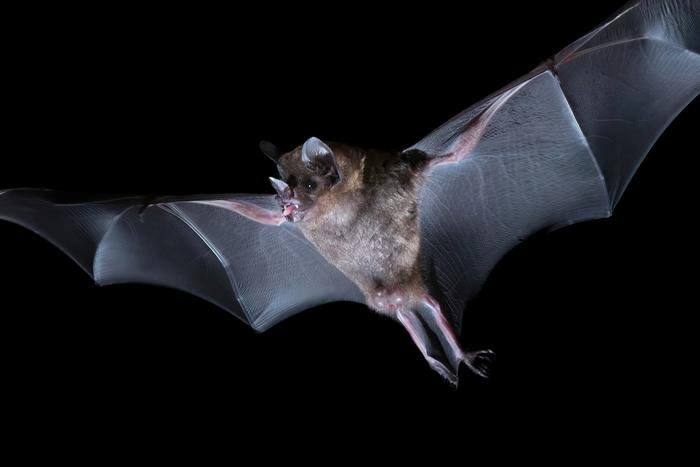FRANKFURT. Seba’s short-tailed bat (Carollia perspicillata) lives in the subtropical and tropical forests of Central and South America, where it mostly feeds on pepper fruit. The animals spend their days in groups of 10 to 100 individuals in hollow trunks and rocky caverns, and at night they go foraging together. They communicate using sounds that create distinct ambient noise in the colony – like the babble of voices at a lively party. At the same time, the bats also use vocalizations to navigate their surroundings: a phenomenon known as echolocation, for which they emit ultrasonic sounds that reflect off solid surfaces. The animals then assemble these echoes into an “image” of their surroundings.

Credit: Julio Hechavarría, Goethe University Frankfurt
FRANKFURT. Seba’s short-tailed bat (Carollia perspicillata) lives in the subtropical and tropical forests of Central and South America, where it mostly feeds on pepper fruit. The animals spend their days in groups of 10 to 100 individuals in hollow trunks and rocky caverns, and at night they go foraging together. They communicate using sounds that create distinct ambient noise in the colony – like the babble of voices at a lively party. At the same time, the bats also use vocalizations to navigate their surroundings: a phenomenon known as echolocation, for which they emit ultrasonic sounds that reflect off solid surfaces. The animals then assemble these echoes into an “image” of their surroundings.
But how does Seba’s short-tailed bat manage to filter out important sounds from constant ambient noise? A common explanation is that the brain constantly predicts the next signal and reacts more strongly to an unexpected signal than to an expected one. This is referred to as deviance detection, and neuroscientists led by Johannes Wetekam and Professor Manfred Kössl from the Neurobiology and Biosensors Working Group at the Institute of Cell Biology and Neuroscience at Goethe University Frankfurt are exploring its mechanisms. Together with colleagues, they were already able to show in 2021 that signal processing does not begin in high-level regions of the brain but already in the brainstem, which is responsible for controlling vital functions such as breathing and heart rate. However, these studies only used artificial stimuli that are not meaningful to the animals.
In a study recently published, the team led by Wetekam and Kössl repeated the experiments with natural communication and echolocation calls. “With our study, we wanted to find out what happens in deviation detection when, instead of meaningless stimuli, ones are presented to Seba’s short-tailed bat that actually occur in its auditory world,” says Wetekam, summing up.
To do this, two electrodes the thickness of a human hair were inserted under the bats’ scalps to record their brain waves. Although this was painless for the animals, the measurements were carried out under general anesthetic, as any movement could distort the results.
The bat’s brain reacts to sounds even when the animal is anesthetized and fast asleep. Either echolocation or communication calls were then played to the animals, each interspersed with the other sound, with a 10% probability of it occurring.
It was then possible to read from the brain waves measured that the brainstem processes echolocation and communication calls differently. While infrequent echolocation sounds indeed induced stronger signals than frequent ones – i.e. showed deviation detection – in the case of communication sounds, the probability of them occurring did not influence the strength of the response. “Bats probably need to react faster during echolocation than when communicating with conspecifics,” presumes Manfred Kössl. “The brainstem is the first station in the brain to receive the acoustic signals, which is why calculating the probability of echolocation calls might be necessary first of all there, and especially their echoes, so that the animal can dodge obstacles in good time.” The stronger response to less frequent calls is presumably due to better neural synchronization.
The study also showed that the brainstem can utilize other features of bat calls for deviance detection, such as rapid changes in frequency or volume, in addition to differences in pitch. “This is astonishing, as the brainstem is a rather primitive part of the brain that scientists did not previously think capable of any substantial involvement in signal processing,” says Wetekam. “They saw its role more in receiving signals from the auditory nerve and transmitting them to high-level regions of the brain.”
These findings might also be important in relation to medical applications in humans. For example, the low-level regions of the brain ought to be included when studying diseases such as ADHD or schizophrenia, which are associated with impaired processing of extraneous stimuli. The fact that the bat brainstem processes various complex acoustic signals differently can also help scientists to understand how the brain deciphers and processes complex human speech.
Journal
JNeurosci
DOI
10.1523/JNEUROSCI.1588-23.2023
Method of Research
Experimental study
Subject of Research
Animals
Article Title
Deviance detection to natural stimuli in population responses of the brainstem of bats.
Article Publication Date
23-Jan-2024




